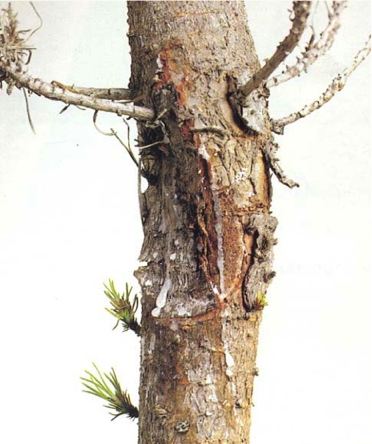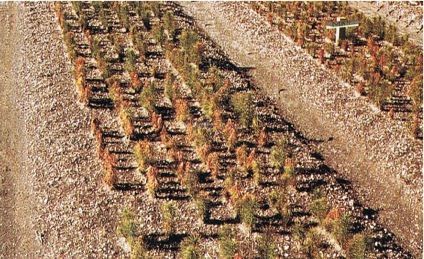PESTS AND DISEASES OF FORESTRY IN NEW ZEALAND
Bacterial stem canker
Scion is the leading provider of forest-related knowledge in New Zealand
Formerly known as the Forest Research Institute, Scion has been a leader in research relating to forest health for over 50 years. The Rotorua-based Crown Research Institute continues to provide science that will protect all forests from damage caused by insect pests, pathogens and weeds. The information presented below arises from these research activities.
From Scion publication Forest Research Bulletin 220,
An Introduction to The Diseases of Forest and Amenity Trees in New Zealand,
G.S.Ridley and M.A. Dick 2001.
Species: Pseudomonas syringae pv. syringae (Bacterium)
Common name: Bacterial dieback and stem canker
Country of origin: Cosmopolitan
Host(s): Pinus radiata. Symptoms: The cankers are usually found between 10 and 30 cm above the ground and vary in size from very small sunken necrotic patches (Fig. 61) to large resinous lesions completely girdling the stem. There are frequently some signs of frost damage (needle scorching, dead buds) on the plants as this disease is associated with frosty conditions. Invasion of dead tissue by wound pathogens such as Sphaeropsis sapinea and Nectria cinnabarina may occur and this will exacerbate the damage. Trees older than 1 year on the same sites are generally unaffected, although occasionally cankered 2-year-old plants can be found. Those plants which are not completely girdled, and that survive the winter months, seldom show any further deterioration. Callus tissue will begin to cover the cankered area with the onset of spring growth, and even very badly damaged trees will show no sign of the infection after 3-4 years.

Fig. 61: Bacterial stem canker on Pinus radiata caused by Pseudomonas syringae pv syringae
Disease development: Bacterial cankering is usually found on grassy fertile sites (frequently converted farmland), and concentrated in frost hollows or on frost flats. The presence of ground cover can have the effect of lowering the minimum temperature by as much as 4°C in comparison with a site where all vegetation has been removed. On bare ground there is little change in temperature with increasing height above the ground, but on sites with ground cover the minimum temperature occurs at 20 cm above the ground (most cankers form in the region between 10 and 30 cm above ground level). Inoculations of 1 -year-old P. radiata with Pseudomonas syringae pv. syringae, with and without frosting, gave the results presented in Table 4.
NZ distribution: There have been occasional incidents of substantial mortality in the central North Island. It is thought to occur throughout New Zealand.

Economic impact: The disease occurs only sporadically as its occurrence is dependent upon a particular sequence of weather conditions. It has been of little consequence so far.
Control: Direct control of this ubiquitous pathogen is not practical. Removal of vegetation from around seedlings reduces the risk from bacterial canker.

Fig. 62: Pinus radiata infected with Pseudomonas syringae pv. syringae in a forest nursery
Notes: Periodically, localised mortality of 1-year-old Pinus radiata is associated with cankers on the lower stem of affected plants. Pseudomonas syringae pv. syringae is readily isolated from cankers in an early stage of development, and inoculation tests have demonstrated the pathogenicity of the organism. The same bacterium is responsible for a dieback disease of Pinus radiata seedlings in nurseries (Fig. 62). Pseudomonas syringae is active as an ice nucleus and can initiate the formation of ice crystals, with resultant damage occurring to plants at temperatures generally not low enough to cause injury. A sudden drop in temperature favours the disease after a period of mild wet weather, which has prevented plants from hardening and has also promoted bacterial growth. Infection is therefore most common during winter or late autumn.
References: Dick 1985a, b; Langridge & Dye 1982; Menzies & Chavasse 1982.
This information is intended for general interest only. It is not intended to be a substitute for specific specialist advice on any matter and should not be relied on for that purpose. Scion will not be liable for any direct, indirect, incidental, special, consequential or exemplary damages, loss of profits, or any other intangible losses that result from using the information provided on this site.
(Scion is the trading name of the New Zealand Forest Research Institute Limited.)

 Farm Forestry New Zealand
Farm Forestry New Zealand

